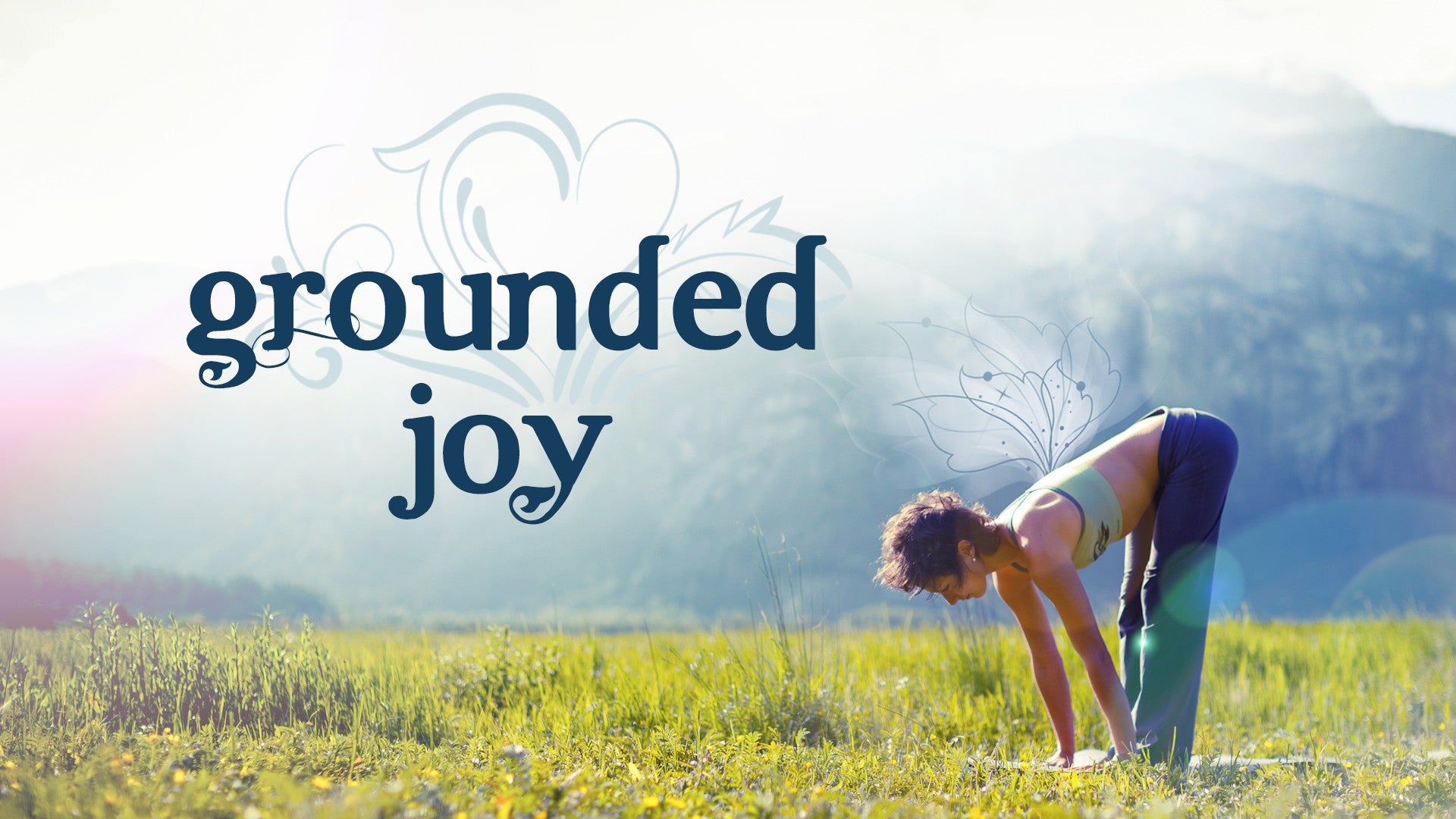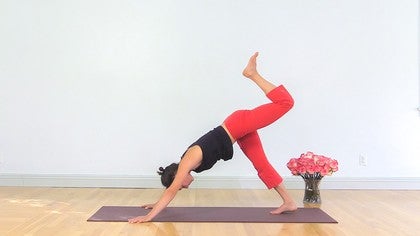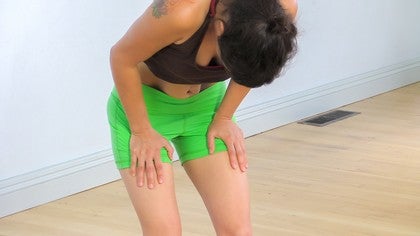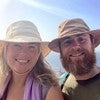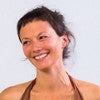Description
About This Video
Transcript
Read Full Transcript
(waves crashing) Hi, so the impetus for this practice for me has been watching my nine month old son learn to crawl. And the way that he moves and his progression of movement has been so fascinating to me as a yoga teacher and a body worker, and I'm just seeing that there are so many postures that we do that are actually so incredibly innate in the body, and just this quest kind of to find strength in through the central axis of the body that I watch my son do. I've come to the conclusion that moving from the tips of the body, from the fingertips and the toes, and kind of propelling the body forward and back without too much tension in the midsection of the body and around the spine is a really efficient way of moving. So I've been exploring this, I hope you like it. So let's start by coming up to standing.
And before we move into the flowing sequence, we're going to practice a kriya or a cleansing movement in standing to build a little bit of heat, since the sequence is a little bit short, and just get us into our breath. So the breath that we're gonna be doing is called kapalbhati, and I like to think about that breath as like a little bouncy ball in the lower belly. So it's a strong exhalation, snapping the lower belly like a bouncy ball, back towards the spine, and then the inhalation is passive, so we just let the belly expand or the lungs expand on their own, and then we snap the belly back, and then the inhalation is passive. So I'll give you a sense of that just with a couple of breaths. (sharply exhaling) So it's actually nice to put your fingers on the lower belly, because with touch you can actually feel if the lower belly area and that sort of deeper transverse abdominal area is snapping back towards the spine.
We're gonna do this practice standing at the top of the mat and taking the arms up, one kind of moving towards the opposite shoulder blade, and the other moving towards the opposite shoulder blade, and then leaning the base of the skull into the wrists or the forearms. So if this is kind of tweaky on your shoulders, you could do this practice just with your arms up and grabbing onto opposite forearms, because it can be a little bit demanding on the shoulders. So we'll take our hands into that position, lean back, widen the back body, close the eyes, and start to do the kapalbhati breath. (sharply exhaling) So continue on but if you want to speed it up just to increase the intensity for yourself and build a little bit more heat, then that's also possible. (sharply exhaling) So continue on just for a few more seconds, I just wanna talk about that this is like an upward movement with the snapping back of the belly, going up towards the skull, and it translates to skull shining breath, it's kind of cleaning out your sinuses.
(sharply exhaling) So a few more here. And then exhale everything with the long exhalation. Ground into your feet, inhale, take your arms up, lengthen through the entire body, and exhale, let your hands come down by your sides. So I don't know if that built a bit of heat in you, you could also do that for a little bit longer. If you have a short time to practice, it's kind of nice to do that first.
So feet together at the top of the mat and just notice how you can lean into your toe tips and then sort of the energy of the front of the body lights up. So kind of the quadriceps, the abdominal wall, the chest, maybe up into the throat you could feel. And then lean into the heels, and really drive the heels down, and see if you can feel sort of a current of energy coming up through the back of the legs, through the hamstrings, through the sacrum area, through the lumbodorsal area, maybe even into the back of the neck and the back of the skull. So to even this out, let's lean into the tips of the toes, sort of like you had tree frog feet and they were just like suction cupping into the earth. And then the heels, the full circumference of the heels, and just see if you can really plug down into these tips and soften up through the body.
So there's not this like feeling of avalanches of tension in certain areas, maybe the quadriceps or the low back or the traps. Get long, take a nice deep ujjayi breath. Exhale completely. Inhale, take the arms up, you might wanna look up. Exhale, bend the knees and fold over the legs.
Inhale, extend through the crown, which is also a tip of the body, and take your hands down to the floor. Take a nice long inhale again, lengthen, and exhale, step or hop back into feet together downward facing dog, really landing into the strength of your legs. Straightening the legs any amount, maybe keeping a little bend if it helps you keep the sit bones high, and then roll forwards towards the plank pose, maybe snuggle your feet back a little bit, and we're gonna pause here for a few moments. See if you can keep the feet together and the knees magnetized towards each other, because this gives you a sense of diving up into the pelvic floor into the back of the abdomen and maybe even up into the diaphragm and the throat. So finding the deep front line of strength through the axis of the body.
So let's see if we can lean into the toes and that propels you forwards, and lean into the fingers and that pushes you back, and just feel those forces acting. My son does this a lot in plank pose and also on his knees, just kind of shifting the weight forwards and back. And then let's see if we can do both of those actions at the same time, the fingers kind of push you back into your heels, the toes push you forwards into your crown, and then see if you can relax the front abdominal wall and sort of extend through your spine, instead of compressing like an accordion through your center. Take a couple of breaths. And then let's pitch the hips up and back into downward facing dog, maybe you wanna move the feet a little bit closer, and breathe.
Bend the knees, from the power of your toes and the power of your fingertips, step or hop forwards, inhale, then exhale, fold. Then inhale, come all the way up, feeling the toes root and the heels, and exhale into the center, moving right into a second, inhale, the arms up. Central channel is hollow and open, exhale, fold forwards over your legs. Inhale, find a long spine, find your fingertips, lean into your fingertips, and find your toes, exhale into the downward facing dog, feet together. Wiggle your feet back a little bit maybe so you're a long downward facing dog, and inhale, roll towards the plank pose.
And let's again just find this rocking action, forwards and back, from the fingertips, from the toes, and see if the abdominal wall can actually get a little bit longer, so that you're not compressing the organs or the hip flexors, and you feel a sense of kind of diving up through your core, with length in strength. Then let's pick up the right leg, see if we can pause here, body in relatively straight line, and cross the right leg over the left, and then squeeze a little bit through the inner legs. And breathe, see if it's possible to keep the armpits a little bit hollow and wide here. And then let that foot come down, lift the left leg up and cross, and squeeze a little bit through the center. And I've seen my son do this before, seriously, which just was amazing to see him cross and sort of squeeze in through the midline.
And then release, pitch the hips up and back, and come into downward facing dog. Finding space in between the scapula, maybe even bending the elbows, giving more weight into the fingertips and then magnetizing the inner elbows towards each other, making the arms one size longer. Exhale, soften the knees, find the toe pads. Lean into the fingertips as you come forwards, inhale, and exhale, fold. Let's come up, toe pads and heels are heavy.
Inhale, and exhale, going right into another one. Inhale, your arms up, find the domes and the arches of the feet nice and high as you exhale and fold up and over your hip joints. Inhale, get a long spine, and feel the center of the crown of the head moving forwards, and then exhale, find your finger tips, and let's just play with this a little bit. Move the hands a little bit forwards, find the fingertips, come high up onto the toes if you can, and maybe your knees need to be bent if there's limitation in the hamstrings here, but see if you can lean so much into your fingertips, that you can kind of lean forwards and do a tiny little hop, almost not really a hop at all, and come a little bit back on your mat. And we'll do it again, leaning into the fingertips, finding the toe tips, and just tiny little hop.
And if you find the tips of your body, you'll feel this diving right up into your lower belly, kind of where that mula bandha and uddiyana bandha area are. So if you have the stamina, might be interesting to go all the way to the back of the mat like this. And finding a length in your inner arm, wide shoulder blades. Then just exhale, release at the back of the mat. Let's come forwards, so it's a transfer of weight into the fingertips.
And eventually it'll be kind of smooth. And it gives you a sense of, you know, people talk about sort of floating around, but it's really just a mastery of transference of weight. So exhale, fold forwards. And inhale, come all the way up, exhale. So without thinking too much about it, let's see if we can take that back into our plank pose, inhale.
Then exhale, the pelvis excursions over the femur heads. Inhale, hands come a little forwards, lean into the tips, and exhale back into your feet together downward facing dog. Inhale, the plank pose, exhale, this time lower into a chaturanga. Or come onto the belly, inhale, a cobra pose if that's better on your lower back or an upward facing dog, let's pause in upward facing dog, and see if you can kind of tug the heels back just a tad, which will lengthen the back of the body as we explored earlier. And then exhale, the knees come down, separate the feet, slide the hands a little bit back, so maybe they're on the mat if they came off, tuck the toes, and come back into downward facing dog.
Let's take a wide downward facing dog, so take the index finger and the thumb to the edges of the mat. Take the big toe to the edges of the mat. So your dog pose is pretty wide, and then lean back. See if you can find the index finger and the thumb line, lengthening the biceps, the big toe lengthening the inner thighs. Then maybe just allow your spine to sink into the warmth of the chest, the heart.
Let your spine sink into the warmth of the belly. Keep the finger pads and the toe pads and the heels bright, see if you can soften your central channel, so there's less gripping around your spine. Take the feet together now at the back of the mat, let's explore with something that I learnt from Angela Farmer called the dying warrior. Inhale, your right leg up, and then bend your right knee, and see if you can not shift your hips too much here but keep your hips level equidistance from the ground. Maybe lift your knee up a little bit in space, see if you can not overarch your lower back.
With a big round movement, take that knee out to the side, underneath you, and across the body to the outside of the mat on the left side. The higher you take this foot, the more intense it's gonna be in the outer hip, so you could also take this leg a little bit lower and maybe bend the knee, if you have sort of IT band issues. But if you take that leg nice and high and then you wiggle the back foot back, you'll start to feel this right IT band getting a really nice stretch and a lengthen. It'll be even more so if you root the tip of your right big toe, and breathe. So that you're not crashing down onto this right hip joint and compressing the space, lift the left inner thigh a lot up towards the ceiling and take a few breaths.
It's nice to have your hands wide like this because it just takes a little bit of pressure off your shoulder joints and gives you sort of a wedge support, instead of stacking joint on joint, which sometimes can actually compress the shoulder head. So let's pull back and try the other side, maybe wiggle it out, you've got a new hip now. And let your left leg rise up. Without shifting the pelvis too much, bend the knee, maybe rise the knee a little higher up in space and see if you can root down your right heel. And then big circular movement around, across, see where you wanna place that leg, wiggle the back leg back, sort of smudge your feet back on the mat, and see if it's possible to take the left big toe tip towards the floor and if you can get it connected, you're really gonna feel lengthening across your IT band.
So that you don't compress this left joint space, you can lift up through the right inner thigh as much as possible. When I've done this with Angela, she actually comes right down to the floor. It's nice to stay strong and awake and alive and up like this, but for some people, I didn't do this on the other side but, it's quite deep, but if you wanted to, you could kind of wiggle wiggle wiggle and come right down to the earth. And that's a lot in the IT band and the lateral line. So when you're coming out of this, pull the dome of the belly back towards the spine, step back into your downward facing dog.
Bend your knees, find the tips of your fingers, tips of your toes, and come forwards, inhale, and exhale. Then come all the way up, inhaling, and exhaling. So I wanted to play with another kriya practice, another cleansing practice called uddiyana bandha, and maybe take it into agni sara and nauli. So what we're gonna do is bend down almost like you're in like an utkatasana, sitting on a high chair, and take your hands on your knees. So if I was doing this practice, I would usually have my hands on my knees, but just for the purpose of you being able to see my belly, I'm gonna take my hands up by the thighs.
And I'm gonna have to show you my belly, you don't have to do this but if you're at home and you have a mirror, it's actually really informative to be able to see your belly in this practice. There's something about the ability to see that makes you feel like, you know, you can feel a little bit better for some reason. And this cleansing practice is amazing for cleaning out the guts, so if that is something that you're curious about. So you can take your hands either here, or for me I'm gonna take them here, and we're gonna take a huge inhale breath, and exhale everything, finding the bottom of your exhalation. I do this out of the mouth.
And then at the bottom of that exhale we let the belly hang, almost like you're three months pregnant. Total relaxation of the belly. And then you're empty of breath and you suck in the belly, almost like a mock inhalation. Let it go, let the rest of your exhale out, and inhale and come up. So let's try that once together, so inhaling.
Exhaling everything. Let the belly go. And inhale, come up. That's gonna develop quite a bit of heat and also allow you to access some of the deeper abdominal muscles back towards the spine. I'm gonna take this one step further to pump the belly in and out on the exhalation, so you're empty of breath.
This develops even more heat and does more cleansing in the abdomen. So let's check it out, so inhaling fully. Exhale fully. Let the belly go. Rest of the exhale out, and then inhale and come up.
So all of that is on empty breath, and maybe you just wanna start with like two pumps, and you can actually start to do that quite a bit faster if you get the hang of it and it doesn't feel like your head is gonna explode or anything, so we wanna keep the nervous system quiet in this, but also feel the strength and the heat. And this is really developing a power center in the low belly. After pregnancy, I found this so helpful to feel connected from the tips of my toes to the top of my skull again. Let's take a look at it maybe a little bit quicker. (long exhale) If you have any liquid in the belly or food, especially food, it's not gonna feel as good to do this practice.
Liquid, you're gonna hear the liquid sloshing around in the belly. I wanted to show you one more that you can try, which would take you into nauli, which we're not going to do today. But what we're gonna see is just releasing the most superficial band of muscles, the rectus abdominis, and keeping the deeper transverse abdominal muscles sucking back towards the spine. So you're starting to isolate the abdominal muscles, which is super helpful in just finding control and then also putting everything back together as a whole, if that makes sense. Like taking it apart to put it back together, then you just know more about it and you have better control.
So to do that, I'll show you what it looks like, but then when I was starting to do it, I actually took my hands on the sides of my rectus abdominis, which is your six pack, and pulled it out like that. So I'll show you what it looks like and then I'll show you what I did to get that feeling. (long exhale) So that's what it looks like. This is what I did to get that feeling. (long exhale) Let go.
And as you can see when I let it go, then I suck it all back in and then release it again to come up. So, maybe you're sweating like me, but that develops a lot of heat. We're gonna try that in horse stance, which is a wide space, and see if we can get a few of the agni sara pumps in that practice. So again coming to the front of the mat, and let's just lean into the right foot and really slowly take the left foot back, seeing if you can stabilize around the knee joint, and then just opening yourself up to the side like a wide legged forward fold, and turn your knees, your thighs, and your feet out to the side. Just take your hands on your low back, and as you come into a wide legged squat, just check out that your back isn't getting ropy and tight around the spine, that you can keep like a bit of width and breadth across the back and the back stays in neutral as you come down.
So that might mean for some people shifting the weight a bit forwards and not coming into a lordosis or a really arched lower back. So as you come down, you can take your hands either on the knees, on the middle of the thigh, or on the top of thigh and take the heels of the hands and kind of lean down in there, the shoulders are come up around the ears, but that's actually okay for this practice because the traps can stay nice and soft. So let's just take a few breaths and just kind of shift your knee over your second toe, one side and then the other, kind of just feeling out this nice deep squat. Feeling the heat of the practice we've already played with and allowing the inner thighs to just get a sense of opening. So I'll let you see this from the belly.
So again, we're gonna take a nice deep inhale, and it's a bit harder when you're upright like this. Exhale fully, let the belly go. Exhale everything and inhale, and we're gonna stay in this and do it one more time, so inhaling. Exhaling, let the belly go. Inhaling and then lean into your feet, exhaling, and then come up.
So those are cleansing practices, and sometimes when you stay in a posture for a really long time, you're also getting like a tapas, cleansing heat through the body and it's very purifying. So let's turn the toes in, heels out a little bit, take the arms behind you, interlock the fingers, and just bend the elbows a tad here, so you're not hyperextending through your arms, soften the elbows, inhale, open the chest, exhale, fold forwards. And just allow the hip joints to feel spacious and then bend the elbows and feel the elbows are actually moving down towards the floor. And then when the elbows get a good connection of down towards the floor, the shoulder blades can stay wide and maybe you start to straighten the arms. This posture gets overdone a lot.
So it's okay to just go like halfway, as long as you're getting breadth across the chest, width across the collarbones, breathe. Inhaling, coming up a little bit, release your arms. Walk around to the front of your mat. Exhale into downward facing dog. Come down onto your knees, let your hips come back onto your heels, slide your hands back, and let your elbows get heavy.
So with these kriya practices, these cleansing practices, if there's anything that you need to clean out of the body and the mind, you might just bring that into your field of awareness. Breathe it out. Just asking yourself why you do things. And we're gonna roll up from here and come into shavasana. So it's nice to sort of roll back nice and gradually.
Set yourself comfortably. Let your legs come out. Just notice if you feel any energy in your fingertips and your toes since you've put a lot of awareness into those parts of your body. You can wiggle them a little bit, and as you move your awareness into your periphery, it's interesting for the brain, getting a more whole feeling tone of the body. Let your body, your back, feel really wide with your breath, and let the belly sink into the width, let the spine sink into that width.
Just like you've created a canoe of support and you're just drifting in that space. And you can always come back to it. You might wanna stay here for a while, as I often do, if you have the time. But for this practice, you might wanna pause it, and for this practice we're gonna come up and just do a short pranayama. So you can roll over onto one side, just feel the transfer of weight there.
Feeling the belly kind of, the aliveness of your belly slide over to one side in relaxation. And we'll come up to a comfortable seat. So for sama vritti pranayama, this is equal length inhale and exhale. I like to have the heels of my hands by the tops of the thighs, and the elbows nice and wide. But without slumping, so the top three ribs are actually rotating up, but the elbows are wide and the shoulder blades are wide, so that you have a lot of space in the front of the lungs and the back of the lungs.
Tuck the chin a couple of degrees and let your eyes close. And exhale your breath, counting to three internally. Pause at the bottom of the breath. Then inhale that same count, same rhythm, to the top of the breath, watching it, pausing at the top, then exhale. Three counts, so just continue on your own, maybe as you relax into your body, the breaths become a little bit longer but without forcing.
Maybe the pauses become a little bit longer and more spacious but without forcing. Last few breaths here. Feeling the skin of your body just very, ever so slightly moving towards the center, this is called prana bandha. Just to feel that you're completely here, grounded in your body. Last exhale here.
Return to your normal breath. Let your hands come together at your heart. Let your eyes open. Thanks for practicing, namaste.
Grounded Joy
Comments
You need to be a subscriber to post a comment.
Please Log In or Create an Account to start your free trial.
